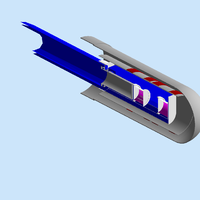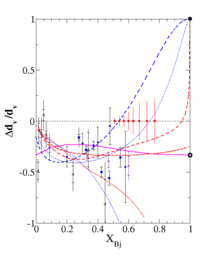Difference between revisions of "2018 NSF Proposal"
| Line 31: | Line 31: | ||
The 2015 NSAC long range plan identified measurements of the fractional polarization of down quarks in the nucleon ($\frac{\Delta d}{d}$) as providing "important | The 2015 NSAC long range plan identified measurements of the fractional polarization of down quarks in the nucleon ($\frac{\Delta d}{d}$) as providing "important | ||
insight on nucleon structure." | insight on nucleon structure." | ||
| − | Fig.~\ref{fig:DeltaDoverD} show the data for $\Delta d(x)/d(x)$ from HERMES and JLab measured in a kinematic range where the down quark carried a fraction of the nucleon's momentum ($x_B$) that was less than 0. | + | Fig.~\ref{fig:DeltaDoverD} show the data for $\Delta d(x)/d(x)$ from HERMES and JLab measured in a kinematic range where the down quark carried a fraction of the nucleon's momentum ($x_B$) that was less than 0.6. The HERMES measurement used both Inclusive and Semi-Inclusive Deep Inelastic (SIDIS) scattering while the JLab measurements used fits to inclusive electron scattering measurements of polarized structure functions ($g$) and unpolarized structure function ($F$) of the proton, deuteron, and He-3 as well as the ratio of up and down quark distributions from proton and deuteron data. |
While the constituent quark model (CQM) predicts that $\frac{\Delta d}{d}$ remains negative as $x_B$ approaches unity, perturbative quantum chromodynamics (pQCD) predicts that it will become positive, as shown in a Fig.~\ref{fig:DeltaDoverD}. This large difference between the two predictions now relies on experiment to resolve the disagreement. The current measurements shown in Fig.~\ref{fig:DeltaDoverD} have not shown a clear indication of this predicted sign change as there is a sparsity of data beyond $x_B > 0.5$. There is a clear need to perform measurements above $x_B$ of 0.5 in order to evaluate the veracity of the pQCD and CQM predictions. | While the constituent quark model (CQM) predicts that $\frac{\Delta d}{d}$ remains negative as $x_B$ approaches unity, perturbative quantum chromodynamics (pQCD) predicts that it will become positive, as shown in a Fig.~\ref{fig:DeltaDoverD}. This large difference between the two predictions now relies on experiment to resolve the disagreement. The current measurements shown in Fig.~\ref{fig:DeltaDoverD} have not shown a clear indication of this predicted sign change as there is a sparsity of data beyond $x_B > 0.5$. There is a clear need to perform measurements above $x_B$ of 0.5 in order to evaluate the veracity of the pQCD and CQM predictions. | ||
Revision as of 02:46, 5 November 2018
RFP Due date Dec. 11
https://www.nsf.gov/pubs/2018/nsf18564/nsf18564.htm
Project Summary
We propose to continue a program of using electromagnetic and electroweak probes to study hadronic matter on a fundamental level at the Thomas Jefferson National Accelerator Facility. As part of this program, each principal investigator will be taking a sabbatical to lead the flagship measurements of this program during this funding period. We are requesting support from the NSF to complete these measurements that our graduate students will be using for the degrees in Physics.
Intellectual Merit
The intermediate energy nuclear physics group at Idaho State University (ISU) has an established fundamental physics program, based at Jefferson Lab, to enhance our understanding of nucleons and nuclei. The CoPIs in this proposal are all co-spokespersons on experiments to perform measurements on the underlying symmetry and structure of the quark and gluon components of the nucleon and the characteristics of the skin or surface of a nucleus. Dr~Dustin McNulty is continuing his work using parity violation to precisely measure the neutron skin of lead and calcium to test nuclear model predictions of the difference between the radii of protons and neutrons in a heavy nucleus. Dr.~Tony Forest is continuing a measurement of the down quark fractional polarization in the nucleon to test predictions of pQCD via JLab experiment PR12-06-109. Two graduate students will perform measurements during this funding period that will form the foundation of their Ph.D. thesis.
Broader Impacts
In addition to the scientific program described here, this proposal represents a major effort in the area of educating future scientists. The present shortage of graduate students in experimental and theoretical nuclear physics is having a detrimental impact on our national laboratories and facilities which posses a plethora of data but limited manpower for analyzing and disseminating the information. The Idaho State University Department of Physics tenure and tenure-track faculty all have research interests which are connected to nuclear physics and are in a position to directly address the shortage of graduate students. With its on campus accelerator and detector laboratories, the Department focuses on experimental and applied physics, giving students a strong hands-on educational experience.
Project Description
Introduction
CLAS Polarized Structure Function
Nucleon spin structure functions have been measured using deep inelastic lepton scattering (DIS) for over 20 years since the first experiments at the SLAC National Accelerator Laboratory. Interest increased substantially in the 1980s when the EMC collaboration reported that quarks make a small contribution to the overall spin of the proton. This ``spin puzzle led to a vigorous theoretical and experimental effort that continues to this day. Although having a large world data set in a kinematic range that is sensitive to both valence quarks and quark-antiquark pairs, there is a limited amount of data in a region dominated by valence quarks. As a result, research on the quark contribution to a nucleon's structure continues unabated.
The 2015 NSAC long range plan identified measurements of the fractional polarization of down quarks in the nucleon ($\frac{\Delta d}{d}$) as providing "important insight on nucleon structure." Fig.~\ref{fig:DeltaDoverD} show the data for $\Delta d(x)/d(x)$ from HERMES and JLab measured in a kinematic range where the down quark carried a fraction of the nucleon's momentum ($x_B$) that was less than 0.6. The HERMES measurement used both Inclusive and Semi-Inclusive Deep Inelastic (SIDIS) scattering while the JLab measurements used fits to inclusive electron scattering measurements of polarized structure functions ($g$) and unpolarized structure function ($F$) of the proton, deuteron, and He-3 as well as the ratio of up and down quark distributions from proton and deuteron data.
While the constituent quark model (CQM) predicts that $\frac{\Delta d}{d}$ remains negative as $x_B$ approaches unity, perturbative quantum chromodynamics (pQCD) predicts that it will become positive, as shown in a Fig.~\ref{fig:DeltaDoverD}. This large difference between the two predictions now relies on experiment to resolve the disagreement. The current measurements shown in Fig.~\ref{fig:DeltaDoverD} have not shown a clear indication of this predicted sign change as there is a sparsity of data beyond $x_B > 0.5$. There is a clear need to perform measurements above $x_B$ of 0.5 in order to evaluate the veracity of the pQCD and CQM predictions.
One of the goals of experiment PR12-06-109, in JLab's Hall B, is to measure $\frac{\Delta d}{d}$ above $x_B$ of 0.5. Fig.~\ref{fig:DeltaDoverD} illustrates the precision that may be achieved using the CLAS12 apparatus. In particular, the measurement at $x_B$ of 0.7 should distinguish between the two prediction at the 2$\sigma$ level. The comprehensive data set to be collected by experiment PR12-06-109 (co-PI Forest) will also contribute substantially to our knowledge of polarized parton distribution functions for all quark flavors and even the polarized gluon distribution $\Delta g$, which is also being pursued at Relativistic Heavy Ion Collider (RHIC). Through Next-to-Leading Order (NLO) analysis of the world data on inclusive DIS (using the DGLAP evolution equations), one can constrain these distribution functions and their integrals. Existing CLAS data from 6 GeV have already made an impact on these fits. The expected data from the proposed experiment at 11~GeV will further reduce the uncertainties of these distributions.
JLab's energy upgrade to 12 GeV will facilitate the above measurements. The CEBAF Large Acceptance Spectrometer in Hall~B is currently undergoing an upgrade of its detector systems to accommodate the increased energy as well. As a service to Hall~B and to satisfy the needs of experiment PR12-06-109, co-PI Forest has become responsible for the construction of five drift chambers. These drift chambers are approximately 6 feet high and contain over 5,000 wires. ISU has successfully constructed and tested one chamber with two more nearing completion. The ISU clean room being used for this work is shown in Fig.~\ref{delqJLab}.
The pQcd prediction is shown as a solid filled circle while the open circle represents the results from ref ~\cite{ISgur1999}, ~\cite{Roberts2013}. The red dash-dot line is a dyson-swinger euation calculation from reference ~\cite{Cloet2005}. The blue dashed line is an early parameterization of the world data from ~\cite{Leader1998}. The blue line and blue dash-dot curve are parametrization fits to the world data from reference ~\cite{Avakian2007} with and without the pQCD constraint when non zero angular momentum states are included. The solid red and dashed red curves are a more recent parameterization of the world data set from reference ~\cite{JAM15} without and with the pQCD prediction respectively.
pQcdPrid G. Farrar and D.R. jackson, Phys. Rev. Lett. 35 (1977) 1416
Isgur1999 N. Isgur, Phys.Rev. D89 (1999) 034013
Roberts2013 C. Roberts et. al., Phys. Lett. B727 (2013) 249
Leader1998 E. Leader, et. al., Int. J. Mod. Phys. A13 (1998) pg 5573
Cloet2005 I. Cloet et. al, Phys. Lett. B621 (2005) pg 246
Avakian2007 H. Avakian, et. al., Phys. Rev. Lett. 99 (2007) pg 082001
JAM15 P. Jimeniez, et. al., Phys Rev. D89 (2014) 034025, Phys. Lett. B738 (2014) pg 263

